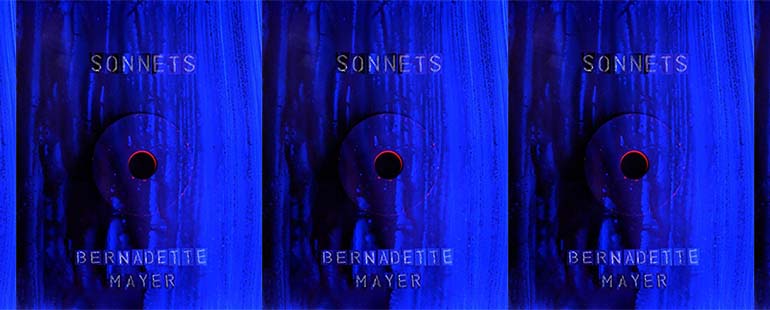Bernadette Mayer’s Deconstructed Sonnets

One of the most traditionally defining features of the sonnet is its “turn,” or volta, a rhetorical shift that marks the point when the poem’s explication pivots into insight. Often beginning with a word like “yet” or “but” that both contradicts and deepens what has come before, a volta signifies the poem’s narrowing towards its close, where narrative development shifts toward resolution. In a conventional 14-line Shakespearean sonnet, that turn falls just before the final couplet; traditional Western poetry often concludes by gesturing towards an abstraction such as the resilience of love or the passage of time.
Times have changed, of course. Generations of contemporary poets have complicated and pushed against the sonnet form, both in terms of its rules and its romantic themes. As formalism in poetry and the expectations around gender and family structure have evolved, so have poets’ treatment of it. Bernadette Mayer’s 1989 collection, Sonnets, reissued in 2014, repurposes the idea of the volta in experimental sonnets, a form she describes as trying to achieve “brief conclusive thought.”
“How serious notorious and public a form,” Mayer writes in the book’s endnote, “to think you could find the solution to a problem or an ending to an observation in one brief moment.” Though many poets have played with and problematized the sonnet, Mayer’s primary concern is a questioning of the sonnet’s volta and the very idea that a poem can be wrapped up in a final, neat couplet. Across her collection, she demonstrates that clear resolution in real life rarely exists, especially in matters of love and relationship.
Mayer uses the scaffolding of fourteen lines as her guide, and relies on the idea of the love sonnet as a fourteen-line open container for experimentation, compression, and the metamorphizing roles of sex and gender in the lives of 20th and 21st-century artists. The range of experimentation within Mayer’s sonnet containers is immense: humor, satire, fragmentation, recursion, deletion, and, most of all, juxtaposition round the corners of each poem. Most significantly, it appears that voltas are absent—or is it that in each poem numerous small voltas are to be found?
Despite this experimentation, Mayer does pay homage to the progenitors of the form, gleefully including words like “thee” and poking fun at sonnet-writing in a self-referential way. In “Incandescent War Poem Sonnet,” she writes, “What’s this? A sonnet? Love’s a babe we know that / I’m coming up, I’m coming, Shakespeare only stuck / To one subject but I’ll mention nobody said / You have to get young Americans some ice cream / In the artificial light in which she woke.” Those last two lines are more of a cultural observation than a conclusion. They’re also a display of the idea that a sonnet can address more than one subject at a time.
Final poetic couplets across the collection reinforce this idea. “Plus a he can’t find a parking space cause the ice is still thick / As the thief of the way a day might memory look,” one poem ends. “Of the hair which is so important the sloped & square / shoulders narrow waists and large hips fixing a date,” reads another. “Communicating mother in fidelity I am thus plus / Which I thought still but without sphere her here.” It can be hard to grasp the exact configuration of the figures in Mayer’s poems, but this may reflect the fact that the speaker’s position is always in flux. One individual lives as a mother, a spouse, an erotic person, a daughter, a neighbor, and a friend all at once. How could this simultaneity of identity possibly be encompassed through linear syntax alone?
Through a different kind of progression and logic, Mayer frees the sonnet from the stop-and-start punctuation that traditionally hinges the turn on the three quatrains preceding the couplet. Mayer takes us into the forest and leaves us there on purpose to release us from the idea that a sonnet is a kind of Google Maps journey from Point A to Point B—or point ABAB, as it were.
The role of the unifying couplet in a love sonnet is essential to a traditional interpretation of the form. The speaker lauds the beloved through the lyric as they approach and encircle each other through an ABAB/CDCD/EFEF/GG rhyme scheme. The last two lines, perfectly matched, represent a romanticized notion of love and coupling. In Mayer’s 20th and 21st-century experimental feminist poetics, however, the realities of love and sex are far more postmodern and far more realistic. What engineer the line schemes here are disconnection despite familiarity, obtuseness in the face of longing, and queerness and gender conflation. Sonnets is ambivalent about love’s abilities: “If we cant get along then who the fuck can? / I will not run or go forward American, divine wind. / A person, I must insist on a heartless agreeing; / A person too, he must agree some love can be.” The breakdown of syntax reflects the fragmentation of communication in a world in which we’re striving for equity but continuing to fall short. Mayer, who was born in 1945, has a poetic philosophy that investigates the range of connection and disconnection between and across genders.
Mayer doesn’t believe a “conclusive” ending is possible in any simple way; instead, she ends poems with couplets like, “This proves all who make love tonight are good poets / & poetesses beg forgiveness before your available hardons.” Frank descriptions of sex appear frequently in these poems, another way in which Mayer de-glorifies romanticized notions of coupling. Gone is the idea that sex is the satisfying conclusion of romance, a sonnet-like happily-ever-after.
Almost all of the book’s far-ranging poems are titled “Sonnet,” an assertion that the form can be many things. In addition to what appear to be slightly more straightforward love poems, Mayer writes epistolary sonnets; six “Incidents Reports” to someone named Grace, with varying levels of erotic confessionalism; and other borrowed forms. For Mayer, a sonnet is not just one thing. The last poems in the book are “skinny sonnets,” poems divided into two stanzas of six and eight lines (a division that reflects the Petrarchan sonnet, the Shakespearean sonnet’s precursor). These sonnets interrupt the expectation of narrative even further: “but rain ok / since dont know u / well as inside & out / oh plate when leaf / might do.” The internal rhymes are a slight nod to sonic tradition, but nearly everything is removed from the skinny sonnets except for the fourteen-line structure and some semblance of rhythm. In the book’s endnote, Mayer writes of “the headlong sonnets which are a way of thinking amidst our hemispheric faults.” The futility of love and relationship, especially the way these ties are fragile and can fall apart, dissolves the traditional view that the speaker’s love for the sonnet’s subject is everlasting, and that this is the strength of their professing. Instead, Mayer’s speakers lean on honesty so that imperfect relationship, too, finds a home in the sonnet.
Aside from intact extended linear narrative, almost anything can and does happen in Mayer’s sonnets. Mayer sets down a fourteen-line glass on the counter and experience sloshes in. Readers are left with a wide-ranging understanding of what relationship can be and how it might be reflected in a formal love poem.
This piece was originally published on October 19, 2021.


